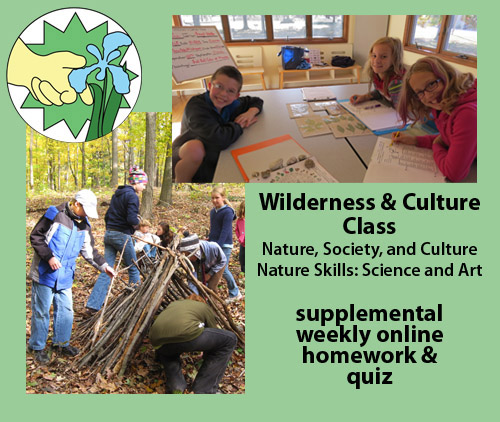z-hub.org > galienvalleyncp > classes > WCclass > homework > week 6 |

Wilderness and Culture Class Week 6 – Week of Oct 18 Monthly Unit: Local Native Habitats Homework Title: Woods Food Web Ecology
Nature: Ecology is studying “the relations and interactions between organisms and their environment, including other organisms.” – dictionary.com Ecology is studying how plants and animals relate and depend on each other for food, shelter, seed spreading, and more within their home, the local habitat. Economy is the “use of something” such as resources and “the management of the resources of a community” – dictionary.com Wildlife has an economy. Wildlife’s economy is nature. Wildlife uses resources in its community (its natural habitat) for food and shelter. Also, people use nature and its natural resources in its economy. People breathe air, drink water, grow food in soil, get lumber from trees, etc. Air, water, soil, trees, etc. come from nature. People depend on nature for food and shelter. Nature is the economy for both people and wildlife. People manage the economy (nature) by increasing, sustaining, or decreasing natural resources. In a primitive wilderness tribe, people got stuff directly from nature. In civilization, people use money to buy stuff from a business that took stuff from nature. Either way, our stuff comes from nature, either directly or indirectly. The origin of all materials in our manmade stuff (low-tech and high-tech), comes from nature. Economy is nature. Nature is economy. Some of the economy truly grows on trees! Even in modern times, even though we may use money, nature is the fundamental base of economy. High-technology is made from rare earth materials that come from nature. Ecology and economy come from the same Greek word, “eco,” which means home. Ecology is learning about and studying our home. Economy is about managing and taking care of our home. Nature is home to both people and wildlife. Below is an ecology image of a few local native flora and fauna of southwest Michigan. It shows their food web relationship to each other. The predators eat the prey for food.
Within a food web, there are many food chains. A food chain is a list of organisms, each of which is food for the next listed organism, which is a larger predator. Following are a few examples of a food chain. The blueberry bush flower nectar is eaten by the hummingbird moth, which is eaten by a blue jay, which is eaten by a pilot snake, which is eaten by a crow, which is eaten by a great horned owl. The poison ivy is eaten by a eastern forest snail, which is eaten by a box turtle, which is eaten by a raccoon, whose dead body (carrion) is eaten by a turkey vulture. You may have fun finding more food chains in the ecology food web image above.
Quiz Six 1. “Eco” come from the Greek language meaning … 2. What is the fundamental base of our economy? 3. Look at the image above of southwest Michigan’s Abridged Food Web Ecology. What does the red fox not eat? 4. Look at the image above of southwest Michigan’s Abridged Food Web Ecology. What does not eat acorns from an oak tree? 5. Look at the image above of southwest Michigan’s Abridged Food Web Ecology. What eats the eastern forest snail? 6. Look at the image above of southwest Michigan’s Abridged Food Web Ecology. Which food chain is true?
|
“Forever learning, living, loving, connecting, caretaking,
having fun, improving skills, and expanding awareness! Hip-Hip-Hooray!”
- Galien Valley Nature and Culture Program
© 2015 Pocket Pumpkin Press, last updated November 2015
Three Oaks, Michigan, USA

